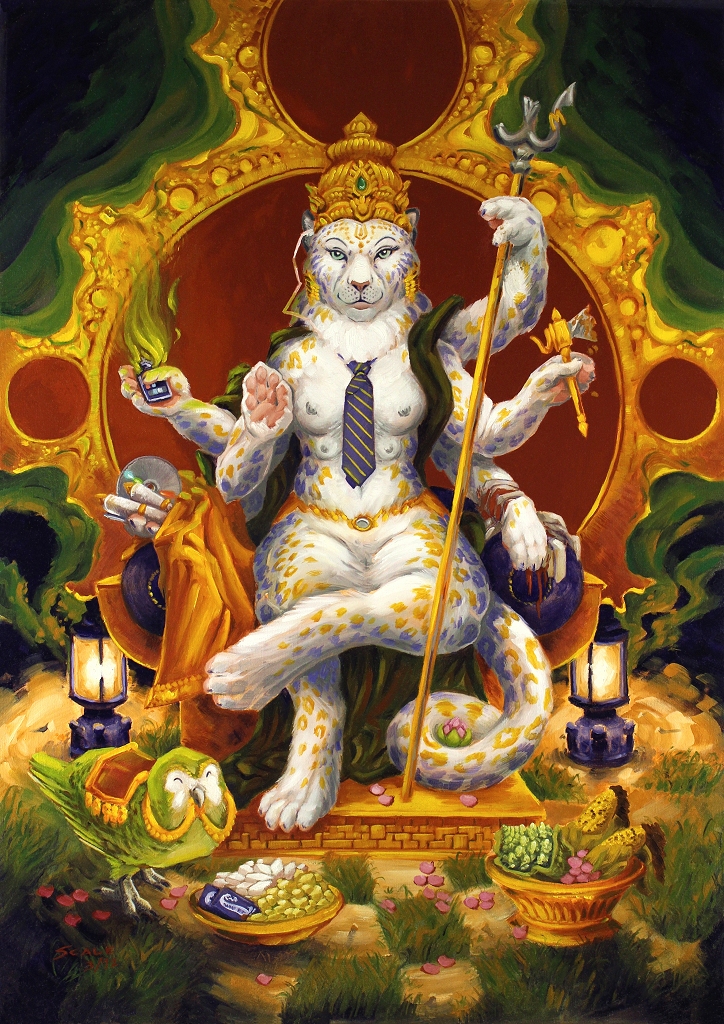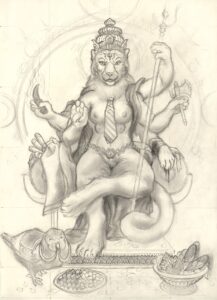
I always liked Hindu religious icons, especially the Ganesha ones. I wanted to draw my own kind of icon with a different species, drawing inspiration from the symbolism of actual Hindu icons but replacing all symbols with my own ones, making them allegories of Western culture and present day facts.
At first I wanted to make the figure a tiger, but since tigers tend to be negative symbols in Hinduism I settled on a snow leopard instead. They used to be rare and obscure creatures until a few decades ago, but nowadays the Western world is obsessed with dragging obscure things under the spotlight, and so the ethereal snow leopard has become a sort of superstar among animals. The figure is mostly nude because modesty doesn’t belong to this age: many people compulsively need to show their goods and possibly their fetishes too (hence the multiple breasts).
The necktie is a universal symbol of corporate power. It may look silly in the picture’s context but there is no mocking intent here. Corporate power is a very solid form of power, and many people devote their life to earning a corporate suit and everything it represents. The head gear is the Karanda-makuta worn by lesser Hindu deities. Nothing changed there, but I made sure the gem in the head gear and the gem in the belt match the color of minerals related to thorium, which seems set to play a vital role for the future of India as a power source. The green gem is a thorite crystal and the gray gem is pure thorium in metallic form. The iPod airbud stands as a little symbol of social alienation. Some people get so lost in their personal worlds that they no longer want to see or hear what happens in the real world around them.
The figure’s companion animal is a kakapo, another obscure animal which has been saved from the brink of extinction and became rather famous because it was disappearing. It looked like a good symbol for the many contradictions in Western attitudes towards nature.
About the items in hand:
- The upper left hand holds a burning smartphone. Smartphones are both status symbols and a powerful tools for ordinary people (especially in developing industrial powers like India), but consumer electronics in general are a huge drain of natural resources.
- The center left hand is casting a blessing with a traditional gesture. Even in the messy world of today religious faith is stronger than ever.
- The lower left hand is holding two scrolls and a DVD. A single scroll was a traditional symbol of knowledge, but today knowledge is so vast that a single scroll can’t be enough to represent it, and even then there a lot of knowledge takes the form of databases and algorithms that require with digital media. The hand and scrolls are partially hidden by a golden veil though, because realiable information is often hidden away and ignored in favor of gilded distractions.
- The upper right hand is holding a broken three-pronged spear. Traditionally there are three categories used to classify worldly things according to their spiritual value: Sattva (things which are pure in their natural status), Rajas (things which have been altered) and Tamas (things which have been tainted or destroyed). Some philosophers used the three categories to classify food, so that natural food such as fresh fruit is considered Sattva, cooked food is considered Rajas, and spoiled or heavily processed food is Tamas. I picked up this food reference and painted the spear with the first two prongs broken to represent the crushing prevalence of junk food and its tendency to replace everything else in spite of its abysmal quality. The McDonald’s logo, of course, the most recognizable symbol of junk food.
- The middle right hand is holding a rusting axe. The axe is a traditional symbol representing the wish to separate matter and spirit: an ideal which is now crumbling as neuroscience progresses and gathers proof after proof that there is no clear separation between matter and mind. Hence the axe in the picture is rusted and crumbling.
- The lower right arm doesn’t end with a hand but with a wounded animal paw. Another symbol of the ambiguous human behavior against nature: there are many suffering paws around the world, and even though we try to repair some of the damage we cannot seem to stop the bleeding.
- The large fluffy tail acts as a reminder that she is not an actual deity to contemplate, but first and foremost an animal who might enjoy being brushed. The tail holds a lotus blossom, a traditional symbol of purity, because in the modern world untamed nature is one of the very few things that feels actually pure.
About the scenery:
- The throne’s shape is an approximation of the Mandelbrot Set fractal, and the shapes of the tiles on the throne’s base should be fairly easy to recognize as bricks from the Tetris videogame.
- The lamps behind the throne are kerosene lamps. They are very diffused in rural households of countries which don’t have an ubiquitous power grid, and they are often the only reliable source of light and heating there. In such conditions owning a lamp can lead to improvements in the quality of life, for example by allowing people to read and study after sunset and regardless of weather. Kerosene lamps are prized because of this but they are a mixed blessing since they are very polluting and prone to cause deadly accidents. They seemed to fit the picture’s theme very well.
- The ground is a patchwork or fertile areas and barren ground, which is often the result of bad land management policies.
- The plate on the left contains kaju-barfi and petha, traditional candies from northern India and the Himalaya region where snow leopards may be found. I’ve also added two Dairy Milk chocolate bars by Cadbury as they are among the most popular industrial candies in India.
- The cup on the right contains lotus petals, maize cobs and a Romanesco broccoli head. Maize is by far the most powerful plant on Earth since it dominates the Western food market, and the USA population in particular is totally dependent on maize for its nutrition. So it deserved to be in the picture as a symbol of arrogance and ignorance of our dependence on the environment. Romanesco broccoli are well known for their fractal shape, so I though they’d be a fine symbol of the nerd mentality which leads to seek interesting pattern everywhere.
The title is a reference to Joseph Fourier, the French physicist who laid the mathematical foundations of harmonic analysis. Harmonic analysis is one of the pillars of computing and has so many practical uses that it influences almost all aspects of contemporary life, and will continue to do so for the foreseeable future. But interestingly, Fourier was also the first physicist to theorize the greenhouse effect.
Original sketch:

